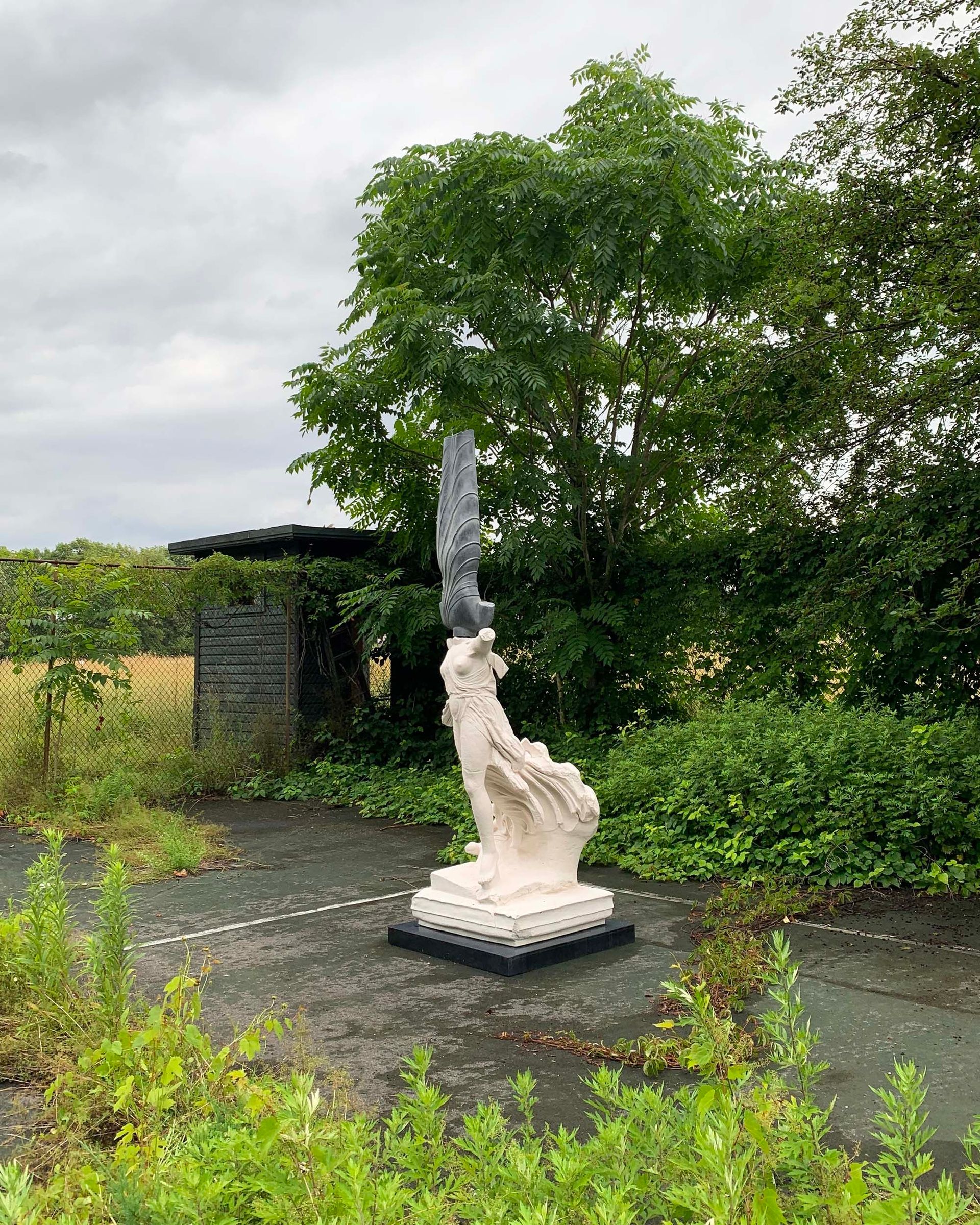A sprawling school building in upstate New York that has been largely abandoned since the 1990s was filled once again with children, adults and dogs in all shapes and sizes when it reopened Saturday (29 June) as The Campus, a new art complex founded by six commercial galleries with locations in Manhattan.
A collaboration between the galleries Bortolami, James Cohan, Kaufmann Repetto, Anton Kern, Andrew Kreps and Kurimanzutto, the 78,000 sq. ft complex in the former Ockawamick School in Claverack spans 40 exhibition rooms, large areas devoted to climate-controlled storage and sprawling grounds that include an overgrown American-football field.
Erika Verzutti’s Venus of Cream (2020) in a courtyard at The Campus Benjamin Sutton
“Climate-controlled storage for all six galleries was always the initial and most critical mission, and we very early on realised that we weren’t going to be able to climate control the entire building,” says James Cohan, co-founder and partner in the namesake gallery. “It became an open discussion amongst the partners: what are the possibilities, and how can we collaborate publicly and get out of our silos?” He adds: “It’s a great work in progress.”
The inaugural presentations at The Campus include a large group exhibition featuring more than 80 artists from the participating galleries’ rosters and beyond, organised by the curator and dealer Timo Kappeller, and Double Down, a showcase of the fifth cohort of artist and curatorial fellows at Nxthvn, the art centre in New Haven, Connecticut, founded by Titus Kaphar and Jason Price (both until 27 October).

Works by Andrea Bowers in the inaugural show at The Campus in Claverack, New York Photo by Yael Eban and Matthew Gamber
The installations unfold throughout the 1951 building’s distinctive, time capsule-like character. The stage in the gymnasium is dominated by an enormous neon green sculpture by Andrea Bowers proclaiming “climate change is real” and several hanging tree-sitting chairs. The gymnasium and an outdoor court feature basketball hoops customised by Trenton Doyle Hancock. An irreverent Miguel Calderón video is projected in the shower of the boys’ locker room. Michael E. Smith invested the cupboards of the home-economics classroom with ceramic and assemblage sculptures. The Nxthvn fellow Eugene Macki filled a closet-like space next to the gym with mounds of scrap cardboard several feet deep below his bas-relief wood sculptures. Jingling interactive sculptures by Haegue Yang look all the more like unwieldy physics experiments here, installed in the science lab. William Forsythe has cleared part of the overgrown football field to stage an absurdly complicated outdoor game.

A site-specific, pastel-on-blackboard work by Sanya Kantarovsky at The Campus Photo by Yael Eban and Matthew Gamber
In other instances, the classrooms, hallways, closets, offices and other spaces function—despite the cinderblock walls, bells, speakers, clocks, lockers and other hallmarks of a school—much like typical galleries. The experience of travelling from one classroom to the next recalls past editions of the Spring Break Art Show, as well as dealer Jack Shainman’s upstate kunsthalle, The School, which opened in 2013 in Kinderhook, around 20 minutes north. But some of the dealers involved in The Campus drew inspiration from an earlier event.
“Andrew [Kreps] and Anton [Kern] both saw the 2006 Berlin Biennale, part of which was in a girls’ school in Berlin, and that was something that really resonated with them,” Cohan says. “One of the big conceits was that we kept the colours of the classrooms the original colour. We were interested in subtly responding to the space, and that opened it up to all kinds of opportunities.” (Location scouts have been drawn to the space’s nostalgic ambience, too: it was used as a filming location for HBO Max’s coming-of-age slasher series Pretty Little Liars: Original Sin.)

Works by Eamon Ore-Giron and Pae White in a former classroom at The Campus Photo by Yael Eban and Matthew Gamber
Kappeller took advantage, for instance, of the former office spaces right at the school’s entrance to stage a sequence of formally resonant paintings by Nathalie du Pasquier and sculptures, video installations and photographs by Barbara Kasten. In one classroom, the creamy hue of the walls complements improbably well the gold tones in a mosaic and giant painting by Eamon Ore-Giron. Another classroom features pastel murals Sanya Kantarovsky made directly on the blackboards. And though one visitor to Saturday’s opening remarked that the venue seems ideally suited to hosting an art fair, Cohan is adamant that The Campus is not primarily a commercial project.
“People kept coming up to me and asking, ‘Which is your gallery, where can I find your artists’ work?’,” Cohan says. “It is very consciously about the art and not about the representation. If there’s one thing that binds all our galleries together, it’s this ‘artists first’ approach. As non-mega galleries, we’re really working for our artists and not just to cover our overhead.”

Works by Nathalie du Pasquier (left) and Barbara Kasten (right) at The Campus Photo by Yael Eban and Matthew Gamber
That ethos seemed to be resonating, and not just during the preview event on Saturday, when hundreds of art-world VIPs descended on The Campus. The next day, during its first ordinary public hours, Cohan says around 450 people visited—impressive given that the site on the outskirts of Claverack (population 6,000) is only accessible by car.
“You do not meet a single person in that area who did not go to that school—they all have their connection,” Cohan says. “I met the woodshop teacher from the 1970s and 80s. I met a woman who went to high school there and is planning a little class reunion there this summer. Everyone was just trying to figure out what the hell is this building ever going to become.”

Xu Zhen’s Eternity – Standing Bodhisattva, Statue of Nike of Paionios (2017-22) on an overgrown tennis court at The Campus Benjamin Sutton
- Inaugural exhibitions at The Campus (Claverack, New York) continue until 27 October




